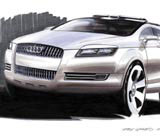Auto motives
Nargess Shahmanesh looks at how the basic shape of the passenger car has evolved in recent years and finds clues as to its future direction

Back in the 1960s, the one and only acceptable shape for cars was the wedge design, best seen on the Ford Cortina. The look was so popular that it carried on into the 1980s, until it was challenged by another Ford model, the Sierra, with its radical half-crescent profile.
Although a cutting-edge design for its time, the ‘jelly-mould’ shape was initially very unpopular with customers. However, the contoured form proved to be much more aerodynamically efficient and economical than what had gone before, and so set the scene in Europe for the extreme ‘blob’ design fashionable today. But now the paradigm is being challenged again, this time by Renault, with the angular features of its latest Avantime, Vel Satis and Mégane models.
‘These cars may not appeal to everyone, but the fact is that it is a new expression of design and taste,’ says Peter Pfeiffer, senior vice-president for design at Mercedes-Benz.
J Mays, vice-president of design at Ford, agrees. ‘I respect the fact that if Renault wants to go in a very avant garde direction, there is a customer base out there for it. At the other end of the spectrum, there are people who want retrospective design, and in between there are probably 15 interpretations of what contemporary modern design will look like,’ he says.
In March, the CLK-Class cabriolet from Mercedes-Benz, due on the road in June, took centre stage at the Geneva Motor Show. The bulk of a cabriolet’s life is spent with its roof down, so, for Pfeiffer, the most important design element is that it should then look like a coupé. But that is hard to achieve on a soft-top, where the material tends to create waves. ‘On this car the roof looks like a metal sheet,’ says Pfeiffer.
In fact, the first CLK design study was shown in Geneva ten years ago. Indeed, 1993 marked a dramatic change in the philosophy behind the Mercedes-Benz brand, with a brave product offensive and a change in design language. From this point, design focus became crucial to the new Mercedes-Benz strategy, says Pfeiffer, with the aim of attracting new, specifically younger, customers.
The E-Class estate, on sale in June, has also undergone a design metamorphosis. Steve Mattin, a Mercedes-Benz senior designer with responsibility for the car’s rear end, explains: ‘In the past, estates were too luggage-oriented as far as packaging was concerned.’ He says that it has become increasingly important to emphasise creating a design-oriented estate car, mainly to tap into a younger market.
For the future, Mercedes-Benz’s more daring brand, Smart, is getting bigger, with a new four-seater to be revealed in the autumn at the Frankfurt Motor Show. But for the time being, the all-new Roadster and Roadster Coupé, on sale in the UK in August, will define the carmaker’s youthful credentials.
If you put the new Roadsters next to the City Coupé two-seater, you already have 100 per cent more identity, says Smart’s chief of design, Hartmut Sinkwitz. ‘We want to attract people who are fed up with cars that do not give a strong experience.’
According to Sinkwitz, when a brand is so young, it is possible to create a new identity for it through the product. ‘With the Roadster,’ he says, ‘Smart is explaining to the public that we are about more than great parking. With the four-seater, design will play a key role in putting across the identity of the Smart brand.’
For Mays at Ford, customers are driving new ideas in car design. He says Ford’s philosophy is exactly as founder Henry Ford laid it out 100 years ago – to provide as much transportation as possible for the masses at a fair price. That theory is reflected in Ford’s most recent project, the StreetKa and SportKa, on sale since March.
The StreetKa is the first entry level convertible from Ford. ‘These are sensational, sexy-looking cars that are right at the entry level,’ says Mays. The models are expected to introduce new customers to the brand.
In terms of design, Mays says the only limiting factor for the carmaker is almost self-imposed. ‘Creating a window in which Ford can operate has helped define the brand much more tightly,’ he explains. ‘We now actually have a brand, as opposed to many disparate nameplates.’
Gerhard Pfefferle, head of design at Audi, says his team is also concentrating more on the visual side of its brand – a direction apparent in the Nuvolari quattro concept, shown in Geneva. ‘The two-seater coupé incorporates many of the design characteristics we will be seeing in future from Audi,’ he says. ‘These include those that underline the performance, as well as the very emotive qualities of the car.’ Audi is now working on the production model, which it says will be very similar to the concept. ‘In the future we will not only see more of the clear lines and the idioms, but also additional elements that give the car a more emotive note,’ he adds.
Pfefferle sees a great future for car design, which will maintain its position as one of the main reasons for buying a car. ‘As technologies become more and more similar, design will become increasingly relevant,’ he adds.
Pfeiffer says defining future styles is always very difficult. He believes the next ten to 15 years will see many more brand-oriented styles coming through. For Mercedes-Benz, he expects continuity in the design philosophy while keeping the differences in each segment.
‘At one point in time there was a view that every future car would look like an egg, because everything would be dictated by ergonomics,’ says Pfefferle. This clearly did not happen. Instead, he adds, we are seeing quite a lot of experimentation in design.
-
Post a comment




